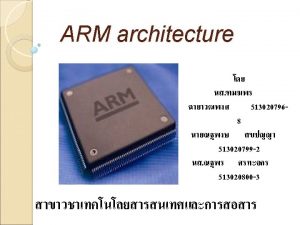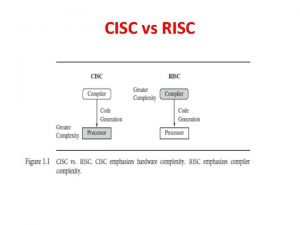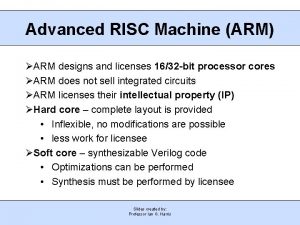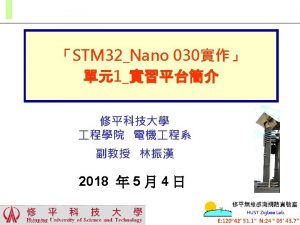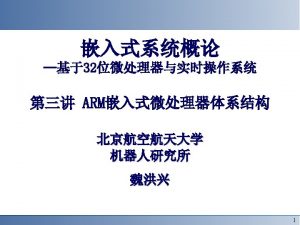ARM ARM history Acorn RISC Machine Acorn Computers








- Slides: 8

ARM

ARM history Acorn RISC Machine (Acorn Computers, UK) ■ Design initiated 1983, first silicon 1985 ■ Licensing model allows for custom designs (contrast to x 86) • Does not produce their own chips • Companies customize base CPU for their products • PA Semiconductor (fabless, So. C startup acquired by Apple for its A 4 design that powers i. Phone/i. Pad) • ARM estimated to make $0. 11 on each chip (royalties + license) ■ Runs 98% of all mobile phones (2005) • Per-watt performance better than x 86

ARM architecture RISC architecture ■ 32 -bit reduced instruction set machine inspired by Berkeley RISC (Patterson, 1980 -1984) ■ Fewer instructions • Complex instructions handled via multiple simpler ones • Results in a smaller execution unit ■ Only loads/stores to and from memory ■ Uniform-size instructions • Less decoding logic • 16 -bit in Thumb mode to increase code density

ARM architecture ALU features ■ Conditional execution built into many instructions • Less branches • Less power lost to stalled pipelines • No need for branch prediction logic ■ Operand bit-shifts supported in certain instructions • Built-in barrel shifter in ALU • Bit shifting plus ALU operation in one (similar to x 86 lea) ■ Support for 3 operand instructions • <R> = <Op 1> OP <Op 2>

ARM architecture Control state features ■ Shadow registers (pre v 7) • Allows efficient interrupt processing (no need to save registers onto stack) • Akin to Intel hyperthreading ■ Link register • Stores return address for leaf functions (no stack operation needed)

ARM architecture Advanced features ■ SIMD (NEON) to compete with x 86 at high end • mp 3, AES, SHA support ■ Hardware virtualization • Hypervisor mode ■ Jazelle DBX (Direct Bytecode e. Xecution) • Native execution of Java ■ Security • No-execute page protection

x 86 vs ARM Key architectural differences (x 86 v. ARM) ■ CISC vs. RISC • ARM with less “legacy” instructions to implement • Legacy instructions impact per-watt performance • Atom (stripped-down 80386 core) – Once a candidate for the i. Pad ■ State pushed onto stack vs. swapped from shadow registers ■ Bit shifting separate, explicit instructions vs. built-in shifts ■ Memory locations usable as ALU operands vs. load/store only ■ Mostly 2 operand instructions ( <D> = <D> OP <S> ) vs. 3 operand

ARM vs. x 86 Other differences ■ Intel is the only producer of x 86 chips and designs • No So. C customization (everyone gets same hardware) • Must wait for Intel to give you what you want • ARM allows Apple to differentiate itself ■ Intel and ARM • XScale: Intel's version of ARM sold to Marvell in 2006 • Speculation – Intel advantage on process to make RISC/CISC moot – Leakage current will eventually dominate power consumption (versus switching current) – Make process advantage bigger than custom design + RISC advantage (avoid wasting money on license) – Not successful

